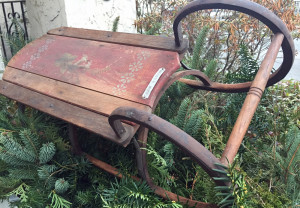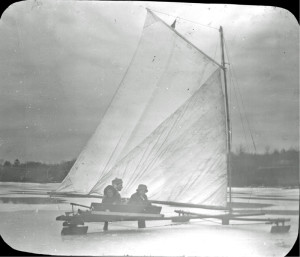Coasting Back in Time
By George T. ComeauThe boys had done this exercise countless times. The weather was perfect and the early December freeze made for excellent conditions. Two old sleds were taken from the Aldrich barn in Ponkapoag. The metal skids had been repaired by the blacksmith and he didn’t charge a penny for work that cost him $4. The boys were building a “double runner,” and soon the shrieks of laughter would pierce the early winter air. This was Canton in the early 1900s.

Mildred Morse Allen’s sled, which was purchased from Jordan Marsh Co. circa 1910 (In the collection of the Canton Historical Society)
In 1971, Canton resident Mary Lou Stocker wrote of her reminiscences in a story called “Yesterday’s Winter.” The story had a romantic longing for a far simpler time than today. There is no doubt, however, that outdoors activities “back in the day” were meant to chase away the cold, and warmth came from building up a sweat. “Pung rides, taffy-pulls, ice boating, and Grange entertainment” all helped brighten up the cold winter days.
Today’s high-tech, breathable clothing is a blessing, yet it wasn’t so long ago that many can recall the scene set in Stocker’s story. “Pulling on scratchy, long-legged woolen underwear was the first step in the layers of clothes needed for warmth. Since snowsuits had not been invented, children protected their legs with leggings that came to their knees. Rubbers worn under the straps of the leggings had been pulled over high buttoned shoes.” Even today, this author can recall an early childhood in which Wonder Bread bags were slipped over our socks and then boots on, our feet kept dry.
Years ago in an interview with Marion Maxim, one of Canton’s oldest schoolteachers, she described the stench of wet wool on the radiators at the Gridley School. If you look behind the school today, you will see the steep hill that children would slide down. One punishment for the kids with wet bottoms was to sit on a board over the radiators until they were dry. It was easy to get soaked at that schoolhouse. The side yard was always filled with snow forts and afternoon recess was held on the ice at Messenger Pond. Children were encouraged to bring their “clamp-on” skates to school and there were many skating parties throughout the season.
And since sledding was the absolute best way to spend an afternoon, the opportunities in Canton were boundless. In the days before cars, you can well imagine Chapman Street, High Street, Norfolk Street, and Ponkapoag Hill as all popular destinations. It was called “coasting” and children as well as adults would have coasting parties at night, wrapping up the evening in a well-lit barn or toasty house for donuts and hot coffee to top the night.
And it is in Stocker’s recollections of sledding and coasting that the past roars vividly through time. “In addition to the old fashioned wooden sleds and the original flexible flyers, double runners were the coasting device used by the most daring.” The scene was set nostalgically. The boys, and yes, generally it was the boys who build these contraptions, would take two sleds and fasten a long plank such that 15 or 16 kids could climb aboard. “A steering wheel attached to the front sled controlled the swoops and turns in the hands of a skillful driver.” It may sound rather unsafe, but there was a sophisticated design that all the boys copied — employing chains that would drop to the ground when a pin is pulled forward, dropping the chain directly in front of the rear runners. The sled could not travel far with a pile of chain under each runner, and the whole sled would stop even when the headway was quite fast.
Perhaps the best part of the old-time coasting story was the amazing route that was by far the finest in all of Canton. The boys would drag the long coaster up to the top of the hill in Ponkapoag, about where the Bradley Estate is now — up on Route 138 in sight of Big Blue. Imagine 16 boys all on the coaster as they set off on the icy, compacted snow. They would “whiz down the hill, round the precarious corner by Crowell’s Store to make a right hand turn onto Washington Street, turn right again onto Red Lane (no longer in existence) and end somewhere near the present Tobe Deutschmann farm.” According to recollections, the trip could take about 30 minutes, but it seems that it would have been much faster. The best part was that Bill Casey, a patrol officer that was popular in early 20th century Canton, would actually stand at the foot of the hill and stop any cars until the double runner would pass.
At night, the adults took over and they too coasted. The young couples with their mittens wrapped firmly around each other’s waist flew through the icy air as if on the set of Frozen. Lovers kissed, while friends giggled, and the entire village would be lit by moonlight and bonfire on those splendid evenings.
Another favorite coasting hill nearby at what is now aptly called Hillcrest Road was particularly steep and fast. There was a small pond named Townsend’s Mill Pond on the edge of what is now the Ponkapoag Playground. Coasters would start at the top of Hillcrest and “steer down the sharp incline facing the pond — the daring riders finishing their run with an exciting slide across the pond itself.”
In 1910, the mill associated with Townsend’s Pond was still standing and it became the winter clubhouse for the neighborhood children. Loose boards from the mill were used to make winter fires to keep small fingers and toes warm against the winter winds. It became a local gathering spot for recreation and a safe place to get inside from the elements.
Winter was a magical time in Canton. The natural resources were abundant, and before the onslaught of subdivisions and new development this was a town that was full of open fields for hunting, sleighing, and even snowshoeing. Stocker completed the story: “If we could, we might find ourselves driving a ‘one-horse open sleigh’ up the old tree-lined Willow Road, now barren-looking Neponset Street. We would stop our horse to watch ice boats with different colored sails zip across the ice-covered fowl meadows … as the crisp air tingled our cheeks, we would never be able to imagine the winters of today when television surfeited youngsters to complain of having nothing to do.”
Short URL: https://www.thecantoncitizen.com/?p=34914











